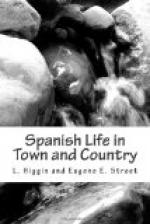In imitation of foreign customs, many of the ladies in Madrid and the more modern cities have established their “day” for afternoon visitors. After all, this is but the Spanish tertulia at a different hour, but if it should ever supersede the real evening tertulia it will be a thousand pities; it would be far more sensible if we were to adopt the Spanish custom, rather than that they should follow ours. In the evening, the hour varying, of course, with the time of year, all Madrid goes to drive, ride, or walk in the Buen Retiro, now called the Parque de Madrid. It is beautifully laid out, with wide, well-kept roads and well-cared-for gardens; it has quite superseded the Paseo de la Fuente Castellano, which used to be the “Ladies’ Mile” of Madrid.
Madrid is a city of which one hears the most contradictory accounts. The mere traveller not uncommonly pronounces it “disappointing, uninteresting, less foreign than most Continental capitals,”—“everything to be seen at best second-rate France,” etc., etc. The Museo, of course, must be admired,—even the most ignorant know that to contemn that is to write themselves down as Philistines;—but for the rest, they confess themselves glad to escape, after two or three days spent in La Corte, to what they fancy will prove more interesting towns, or, at any rate, to something which they hope will be more characteristic. But those who settle in Madrid, or know it well, winter and summer, and have friends among its hospitable people, come to love it, one might almost say, strangely, because it is not the love that springs from habit or mere familiarity, but something much warmer and more personal. One charm it has, which is felt while there and pleasantly remembered in absence—its much-maligned climate. The position of Madrid at the apex of a high table-land, two thousand one hundred and sixty feet above the level of the sea, with its wide expanse of plain on every hand but that on which the Guadarramas break the horizon with their rugged, often snow-capped, peaks, naturally exposes it to rapid changes of temperature; that is to say, that if the snow is still lying on the Sierra, and the wind should chance to blow from that direction on Madrid, which is steeped in sunshine winter and summer for far the greater part of the year, there is nothing to break its course, and naturally, a Madrileno, crossing from the sheltered corner, where he has been “taking the sun,” to the shady side of the street and the full force of the chilly blast, will be very likely to “catch an air,” as the Spaniard expresses it. But that tan sutil aire de Madrid, which Ford seems to have discovered, and which every guide-book and slip-shod itinerary has ever since quoted, might very well now be allowed to find a place in the limbo of exploded myths; it has done far more than its duty in terrifying visitors quite needlessly. That pulmonia fulminante (acute pneumonia) is a very common disease among the




